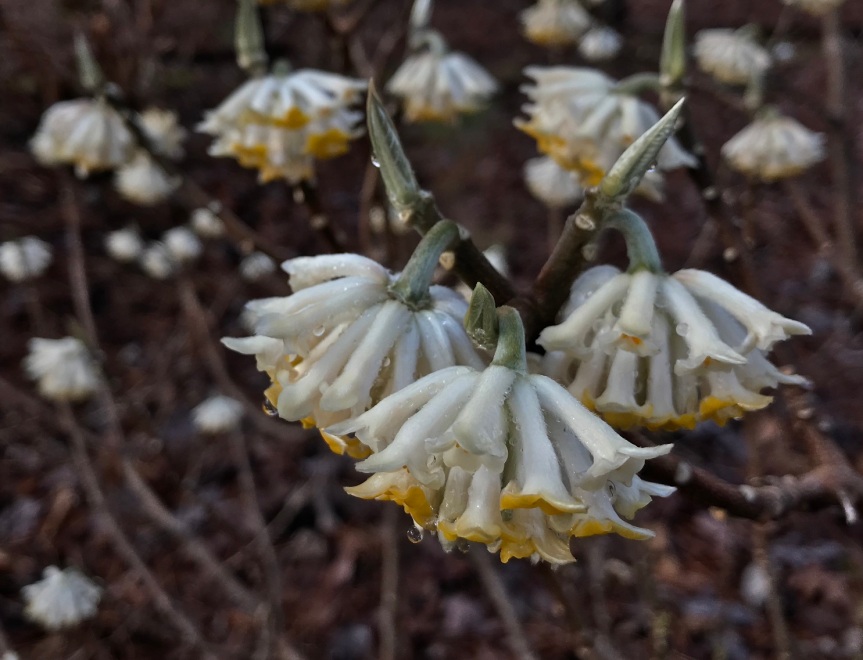
Edgeworthia chrysantha, the paperbush, seems to be making the transition from rare collectors’ item to a garden staple that can regularly be found in garden centers. That’s all to the good, because it is a wonderful plant for piedmont gardens. It is one of the four best shrubs to grow for winter fragrance–the others being Osmanthus fragrans (tea olive), Lonicera fragrantissima (winter honeysuckle), and Chimonanthus praecox (wintersweet)–and for architectural interest, it beats those other three species hollow.

Edgeworthia forms a perfect dome of thick, flexible branches that are covered with large green leaves in summer. The leaves drop after the first freeze, around the time that the fuzzy flower buds begin to swell, so by late December the bare branches appear to be tipped by silvery Christmas ornaments. The flowers open from mid February to mid March in central North Carolina and fill the garden with their fragrance. Currently both Edgeworthia and Lonicera fragrantissima are blooming in my garden. The Edgeworthia fragrance seems sweeter, and the Lonicera more lemony, but both are wonderful. If we don’t have a hard freeze in the next ten days they should be joined by the apricot fragrance of Osmanthus fragrans. My Chimonanthus is still too small to bloom, but in a few years February should smell amazing.

Edgeworthia seems to grow reasonably well in dry shade, but my best specimen grows where it receives rainwater channeled from the end of the driveway and is exposed to direct sun until mid afternoon.



Some websites suggest that Edgeworthia buds can be destroyed by temperatures in the low teens (Fahrenheit), but my plants of the common yellow-flowered variety have tolerated low single-digits with no damage to either buds or branch tips. The orange-flowered form does seem to be more cold sensitive. A small specimen that I planted was frozen to the ground several years in a row and failed to come back last spring.

The common name, paperbush, apparently comes from its use as a source of fiber for Chinese and Japanese paper, although I can’t imagine how anyone could bear to grind up an Edgeworthia for anything so mundane as paper pulp.

Very easy to propagate too. Just pull away and pot up the new stems that appear at the base of the trunk. Do you have Prunus mume (small tree, commonly called flowering apricot)? Great spicy scent, somewhat like cloves, also blooms in February.
LikeLiked by 1 person
Good to know. I haven’t tried propagating it, but my largest shrub has several stems that would be good candidates.
I don’t have the Prunus. Another one to add to The List.
LikeLike
I first saw Prunus mume at the Lan Su Chinese Garden in Portand. Though we call it the by it’s Japanese name (flowering apricot) the Chinese call it “plum” and it is honored as one of “three friends of winter,” along with pine and bamboo. The cultivar I have is ‘Peggy Clark’, which offers bright pink flowers about the size of a nickel. It typically blooms over an extended period, with a portion of its flowers opening during warm spells, but the high temps we had a few weeks ago caused a full flush this year.
Your Edgeworthia snow pic is gorgeous.
LikeLiked by 2 people
This was beautifully done. I must put it on my “wish list.”
LikeLiked by 1 person
I love those little wheels of flowers, the bud is almost better than the bloom! …but I have yet to catch one in bloom and smell that scent.
Oddly enough I was just speaking to some Philly area gardeners who had plans of ditching this shrub. Their arctic blasts were again too much and for a third year the buds are fried.
I on the other hand live in the tundra so don’t even have to wonder what that’s like.
LikeLiked by 1 person
I’m not quite sold on it. Of course, we have many other things blooming through winter, so are not exactly in need of more. It was still rare when a colleague gave one to the arboretum. Those who know what it is really like it. I still do not understand the allure.
LikeLiked by 1 person